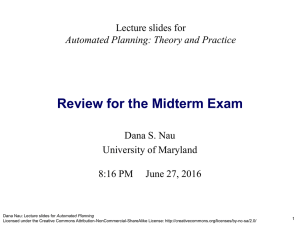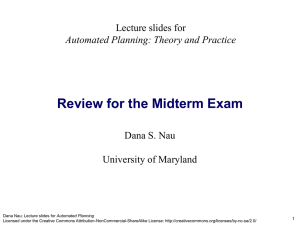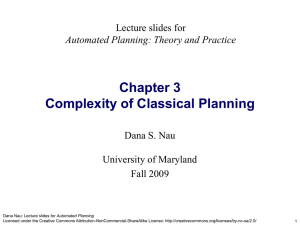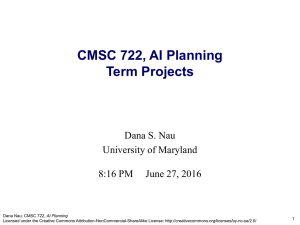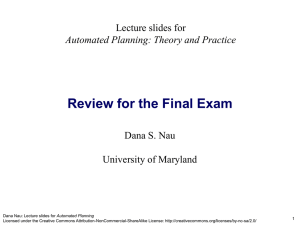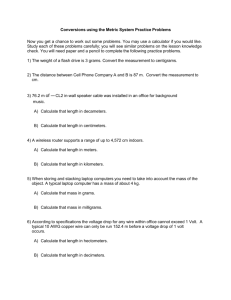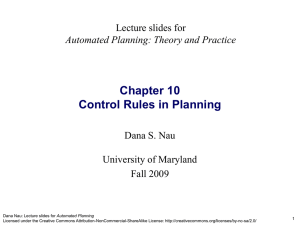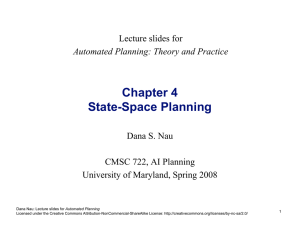Part III Heuristics and Control Strategies Lecture slides for Dana S. Nau
advertisement
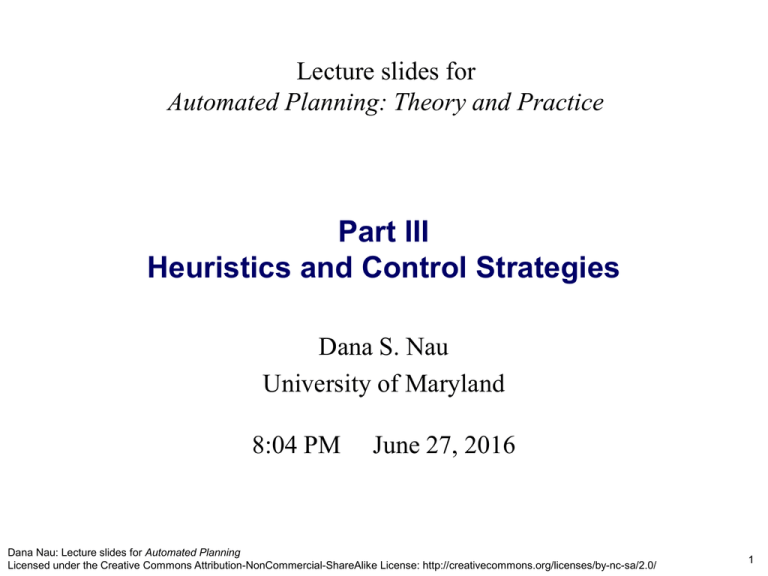
Lecture slides for
Automated Planning: Theory and Practice
Part III
Heuristics and Control Strategies
Dana S. Nau
University of Maryland
8:04 PM
June 27, 2016
Dana Nau: Lecture slides for Automated Planning
Licensed under the Creative Commons Attribution-NonCommercial-ShareAlike License: http://creativecommons.org/licenses/by-nc-sa/2.0/
1
Motivation for Part 3 of the Book
Domain-independent planners suffer from combinatorial
complexity
Planning is in the worst case intractable
Need ways to control the search
Dana Nau: Lecture slides for Automated Planning
Licensed under the Creative Commons Attribution-NonCommercial-ShareAlike License: http://creativecommons.org/licenses/by-nc-sa/2.0/
2
Abstract Search Procedure
Here is a general framework for describing classical and neoclassical
planners
The planning algorithms we’ve discussed all fit into the framework, if we
vary the details
e.g., the steps don’t have to be in this order
Dana Nau: Lecture slides for Automated Planning
Licensed under the Creative Commons Attribution-NonCommercial-ShareAlike License: http://creativecommons.org/licenses/by-nc-sa/2.0/
3
Abstract Search Procedure
Compute information that may affect how we do some of the other
steps
e.g., select a flaw to work on next, or compute a planning graph
Dana Nau: Lecture slides for Automated Planning
Licensed under the Creative Commons Attribution-NonCommercial-ShareAlike License: http://creativecommons.org/licenses/by-nc-sa/2.0/
4
Abstract Search Procedure
Divide current set of solutions into several sets to be explored in
parallel
e.g., B' ← {π.a | a is applicable to γ(s0,π)}
Dana Nau: Lecture slides for Automated Planning
Licensed under the Creative Commons Attribution-NonCommercial-ShareAlike License: http://creativecommons.org/licenses/by-nc-sa/2.0/
5
Abstract Search Procedure
Remove some unpromising members of B
e.g., loop detection, constraint violation
Dana Nau: Lecture slides for Automated Planning
Licensed under the Creative Commons Attribution-NonCommercial-ShareAlike License: http://creativecommons.org/licenses/by-nc-sa/2.0/
6
Plan-Space Planning
Refinement: select which flaw to work on next
Branching: {the flaw’s resolvers}
Pruning: loop detection
recall this is weak for plan-space planning
Dana Nau: Lecture slides for Automated Planning
Licensed under the Creative Commons Attribution-NonCommercial-ShareAlike License: http://creativecommons.org/licenses/by-nc-sa/2.0/
7
State-Space Planning
Refinement: none
Branching: {applicable or relevant actions}
Pruning: loop detection
Other branching & pruning techniques in Chapters 10 & 11
Dana Nau: Lecture slides for Automated Planning
Licensed under the Creative Commons Attribution-NonCommercial-ShareAlike License: http://creativecommons.org/licenses/by-nc-sa/2.0/
8
Planning-Graph Planning
Wrap iterative deepening around Abstract-search
Refinement: generate the planning graph, compute mutex info
Branching: {sets of actions in action-level i that achieve goals at state-level i}
Pruning: prune sets of actions that are mutex
for number of levels = 0, 1, 2, …
Dana Nau: Lecture slides for Automated Planning
Licensed under the Creative Commons Attribution-NonCommercial-ShareAlike License: http://creativecommons.org/licenses/by-nc-sa/2.0/
9
Search Heuristics
Chapter 9: Heuristics in Planning
Heuristics for choosing where to search next
The heuristics in this chapter are domain-independent within
classical planning
Chapter 9
Chapter 9
Dana Nau: Lecture slides for Automated Planning
Licensed under the Creative Commons Attribution-NonCommercial-ShareAlike License: http://creativecommons.org/licenses/by-nc-sa/2.0/
10
Branching and Pruning Techniques
Chapter 10: pruning via search-control rules
Chapter 11: branching via hierarchical task decomposition
These chapters discuss domain-configurable state-space planners
Domain-independent planning engine
Domain-specific information to control the search
Chapter 11
Chapter 10
Dana Nau: Lecture slides for Automated Planning
Licensed under the Creative Commons Attribution-NonCommercial-ShareAlike License: http://creativecommons.org/licenses/by-nc-sa/2.0/
11
Branching Versus Pruning
Two equivalent approaches:
Generate all possible branches, then prune some of them
Just don’t bother generating the ones that would be pruned
Example:
Domain-configurable implementations of the block-stacking
algorithm from Chapter 4
Separate branching and pruning (Chapter 10)
» Branch: generate all applicable actions
» Prune: prune actions that build up “bad” stacks or tear down
“good” ones
Combined branching and pruning (Chapter 11)
» Only generate actions that don’t build up “bad” stacks and
don’t tear down “good” ones
Dana Nau: Lecture slides for Automated Planning
Licensed under the Creative Commons Attribution-NonCommercial-ShareAlike License: http://creativecommons.org/licenses/by-nc-sa/2.0/
12

